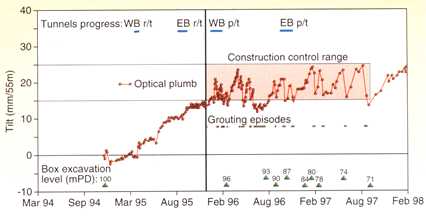
|
|
||||||||
Saving Big Ben
Instrumentation is attached to the buildings in the vicinity to measure movement (with some 7000 monitoring points), and computers are used to analyse the data to calculate where and when the grout has to be injected.

For Big Ben, a movement of 15 mm at a height of 55m ( approximately the height of the clock face above ground level) was taken to be the point at which movement had to be controlled. Grouting episodes typically of 24-hour duration were continued over the whole period during which excavations were occurring - about 28 months. A nail biting time. "Deciding which tube to use for grouting, the volume of grout to be injected and at what rate, is a hugely complex process", explains Professor Mair. "It was calculated that without the grouting, the movement of Big Ben would have gone to well over 100mm, which would have caused unacceptable damage. The beauty of the system is that the grouting pipes are still in place, and the site is still being monitored. Compensation grouting can thus, if needed, be continued until such point as stabilisation is confirmed, although the instrumentation is showing that no further grouting is now necessary."
For more information, please contact Professor Robert Mair - rjm50@eng.cam.ac.uk.